Primary body immunodeficiency - This is a genetic or acquired at the stage of intrauterine development, a disease that is characterized by a complete or partial absence of the protective functions of the immune system.
After infection with pathogenic microorganisms, the patient's blood does not produce a sufficient amount of antibodies capable of resisting bacterial, viral and fungal infections.
Most of the primary immunodeficiency conditions appear in the first 2 years after birth, but also there are varieties of diseases, the manifestation of which is diagnosed after 20-30 years of independent life.
Record content:
- 1 Views
-
2 Stages and degrees
- 2.1 Mild severity
- 2.2 Moderate severity
- 2.3 Severe severity
- 3 Symptoms
- 4 Reasons for the appearance
- 5 Diagnostics
- 6 When to see a doctor
- 7 Prophylaxis
-
8 Treatment methods
- 8.1 Medications
- 8.2 Traditional methods
- 8.3 Other methods
- 9 Possible complications
- 10 Video about primary immunodeficiencies
Views
Primary immunodeficiency is a medical definition that includes a whole range of complex diseases of hereditary and acquired nature of origin.
These are pathologies characterized by the absence of one or several components of the immune apparatus at once, performing the function of protecting the body from the negative influence of infectious microorganisms, external and internal factors.
The table below describes in detail the main types of primary immunodeficiency, the symptoms of which appear at different stages of human development.
| Types of primary immune deficiency | Description of pathology |
| Dee Georgie Syndrome | This is an acquired disorder of the immune system that occurs at 6-8 weeks of fetal formation. The disease is characterized by malformation of the thymus, large great vessels, parathyroid glands and heart muscle. A decrease in the level of the immune response is associated with a defect in T-lymphocytes, which is caused by multiple abnormalities of vital organs and endocrine glands. If the child overcomes the age threshold of 5 years, then the prognosis for survival is favorable.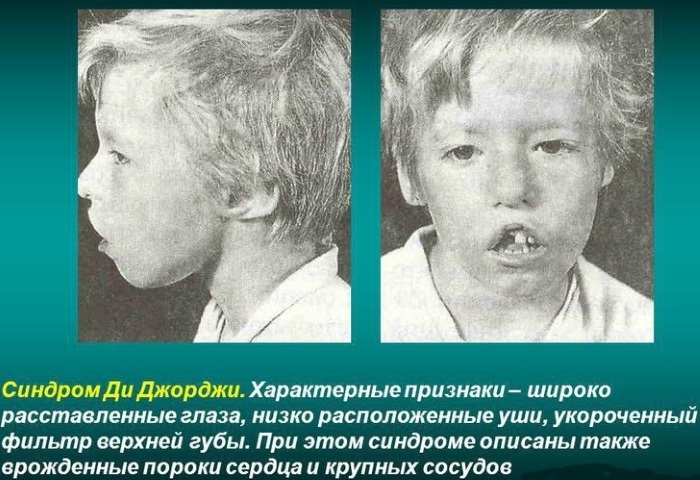
|
| Lymphoproliferative syndrome | This type of primary immunodeficiency differs in that it is inherited exclusively in a recessive manner. Lymphoprofile Syndrome affects only boys. Pathology is characterized by increased sensitivity of the body in relation to the Epstein-Barr virus. After infection with this infection, the patient develops severe complications in the form of chronic fever, lymph node involvement and B-cell lymphoma, which is localized in the tissues of the thin intestines. |
| Purine nucleoside phosphorylase deficiency | This is a severe form of primary immunodeficiency, the inheritance of which occurs in an autosomal recessive manner. Almost immediately after their birth, children begin to suffer from hypoplastic anemia, and also have a very reduced functional activity of T-lymphocytes. |
| Orotaciduria | This is a primary immunodeficiency of a hereditary type, which occurs due to a violation of the synthesis of pyrimidines. Pathology is manifested by active excretion of orotate (orotic acid) in the urine, chronic deficiency of T-lymphocytes, retardation in physical and intellectual development, megaloblastic anemia. |
| Biotin-dependent fermentopathy | This type of disease is characterized by the occurrence of cellular immunodeficiency, the main signs of which are manifested during the neonatal period. The child has attacks of ketoacidosis, signs of skin rashes, alopecia, cramps of the lower extremities, congenital protein intolerance appear. Biotin therapy stabilizes the patient's immune system. |
| Agammagl-obulinemia | This disease is accompanied by chronic deficiency of all types of immunoglobulins. This pathology was first discovered in 1952. Due to low immune activity, already at 1 year of life, sick children are found to have severe complications and dysfunctional disorders affecting the tissues of internal organs and musculoskeletal system. Pathological conditions of the body are caused by bacterial microorganisms. At the same time, viral infections are easily transferred. The prognosis for recovery is unfavorable. |
| Wiskott-Aldrich Syndrome | This type of primary immunodeficiency is accompanied by thrombocytopenia and extensive skin eczema. Infectious processes in internal organs develop at 10-12 months. the life of a child. The main disorders in the functioning of the immune system are associated with the fact that lymphocytes gradually disappear from the thymus and lung tissues. Scientists still do not have information about the nature of the origin of this pathology.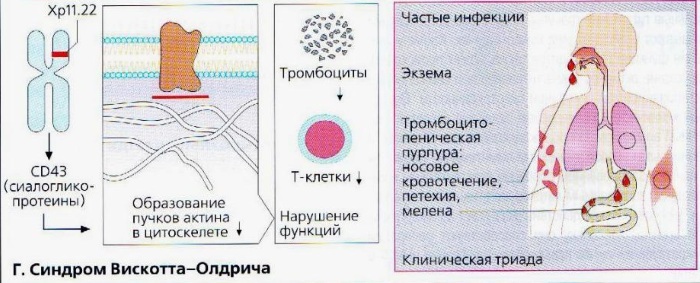
|
| Gitlin's syndrome | This is a combined type of primary immunodeficiency, which occurs due to a lack of growth hormone. Patients are distinguished by backwardness of physical development, suffer from dwarf growth and immaturity of the thymus. In connection with the presence of the latter pathology, disturbances in the functioning of the immune system occur, which lead to the vulnerability of the child to infectious microorganisms. |
| Glanzmann-Riniker disease | This type of primary immunodeficiency was first described by Swiss doctors in 1950. The disease always proceeds in a severe form, and its occurrence is associated with a completely passive immunity. The patient's death occurs in the second half of 1 year of life. |
| Hood's Syndrome | This type of disease is characterized by pronounced immaturity of the thymus, in the tissues of which a tumor (thymoma) almost always develops. Most patients also suffer from hypoplastic anemia. |
| Variable immune deficiency | This type of primary immunodeficiency occurs due to the fact that plasma cells do not produce a sufficient amount of all types of immunoglobulins. In this regard, the human body is vulnerable to infectious microorganisms. |
| Granulomatous disease | This is a hereditary pathology, the nature of the origin of which is associated with the low activity of phagocytes in relation to the bacterial microflora. In this case, the process of phagocytosis proceeds normally. Pathogenic microorganisms absorbed by phagocytes do not die, but retain further pathogenic activity and the ability to cell division. The immune system is unable to perform its function of neutralizing bacterial infection, which leads to severe intoxication of the body. |
| Miller's Syndrome | This type of primary immunodeficiency is caused by a set of hereditary defects that affect the function of leukocytes. A low level of immune response is associated with insufficient migration activity of neutrophilic granulocytes, a decrease in the process of phagocytosis, as well as an almost complete absence of bactericidal function. |
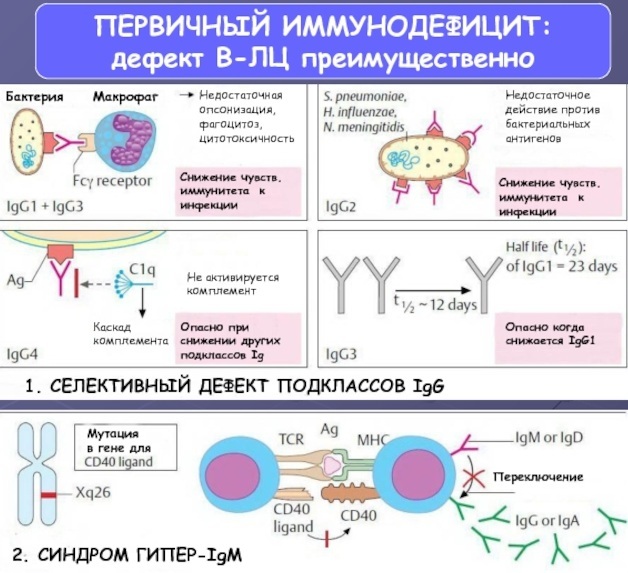
All of the above types of primary immunodeficiency are severe diseases of the immune system, most of which require the regular intake of potent drugs. Regardless of the type of pathology, the patient's body is equally vulnerable to infectious microorganisms.
Stages and degrees
Primary immunodeficiency is a painful condition of the immune system that may be accompanied by minor functional disorders of the body, or lead to severe and irreversible consequences.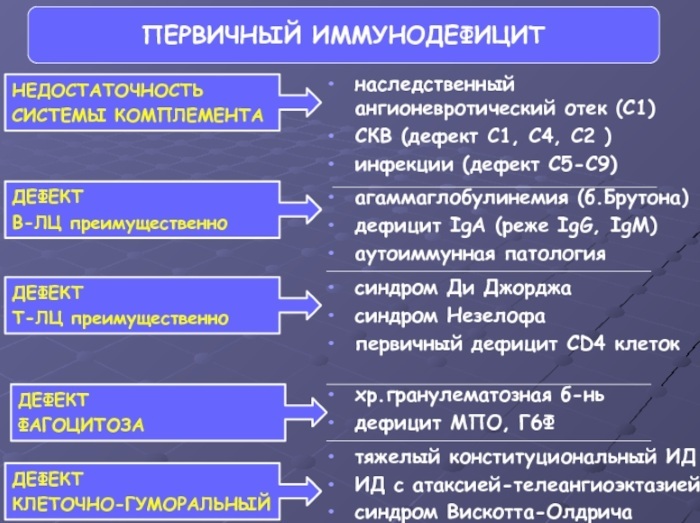 There are 3 main degrees of severity of primary immunodeficiency.
There are 3 main degrees of severity of primary immunodeficiency.
Mild severity
In this case, the decrease in the protective functions of the immune system is insignificant. From the first days after birth, the child is prone to frequent infectious diseases, is characterized by a slow pace of physical development, but at the same time there are signs of an immune response.
Moderate severity
Symptoms of the disease appear already in the first year of a child's life. The pathology is characterized by an extremely low activity of T-lymphocytes, the absence of a local and general immune response to the invasion of infectious microorganisms.
The patient's body is not able to fully resist bacteria, viruses and fungi. In this regard, the child suffers from constant intoxication, dysfunctions of internal organs develop. In the absence of timely drug therapy, the prognosis for recovery is poor.
Severe severity
Severe forms of primary immunodeficiency are accompanied by the presence of completely passive immunity, as well as disturbances in the work of the digestive, endocrine, respiratory and cardiovascular systems.
The child's body receives antibodies only at the expense of mother's milk, which provides him with minimal protection against pathogenic microflora. With the beginning of the first feeding with other products, severe complications develop that affect all organs and systems of the patient. In most cases, death occurs before the age of 6 months.
Symptoms
Primary immunodeficiency is a chronic disease of the immune system, the development of which is accompanied by the manifestation of the following symptoms:
- recurrent infections of the paranasal sinuses, upper and lower respiratory tract, skin, gastrointestinal tract, mucous membranes of the oral cavity (most often caused by protozoa and mushrooms);
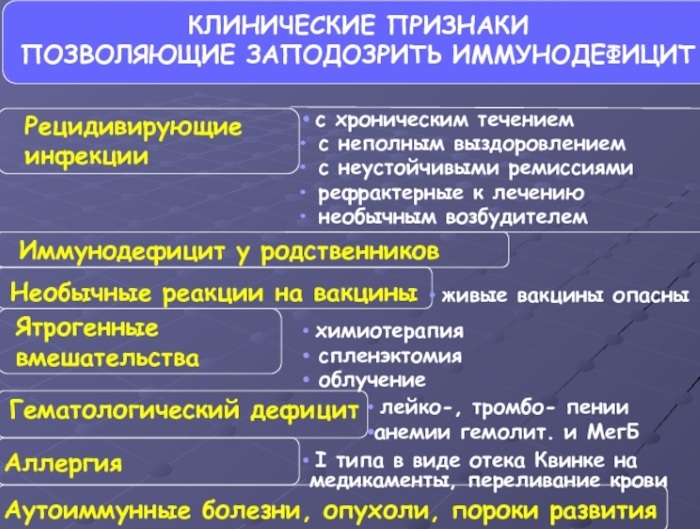
- leukocytopenia, hemolytic and megaloblastic anemia, thrombocytopenia;
- a chronic form of hepatitis, which is most often caused by viral infections;
- autoimmune disorders accompanied by abnormal damage to bone and connective tissue musculoskeletal system (the patient suffers from arthritis, scleroderma, inflammatory diseases skin);
- severe allergic reactions in the form of a red rash, edema of the mucous membranes, itching, eczema;
- the presence of benign and malignant tumors, most of which affect the lymphatic and digestive systems;
- chronic diarrhea accompanied by malabsorption syndrome;
- a tendency to atypical reactions to vaccination (the introduction of live vaccines can lead to severe complications in the form of bacterial blood poisoning);
- malformations of the joints, which primarily affect the cartilage tissue.
The presence of these symptoms is a sufficient reason for a more thorough examination of the body with determination of the cellular composition of blood, as well as its elements that are directly involved in the immune answer.
Reasons for the appearance
Primary immunodeficiency is a severe disease of the immune system that occurs for the following reasons:
- the influence of a hereditary factor, when a tendency to immunodeficiency conditions is transmitted to a child along with genetic information from one of the parents;
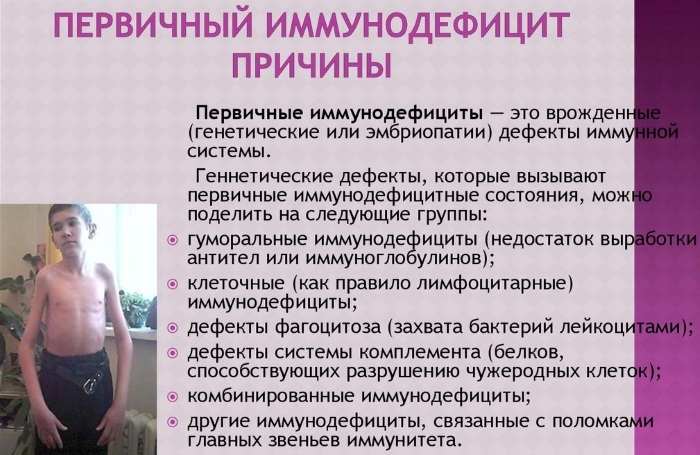
Causes of primary immunodeficiency - anomalies of intrauterine development, which lead to various defects of the thymus and hematopoietic organs involved in the synthesis of cells of the immune system.
These are the 2 main reasons for the onset of primary immunodeficiency. The onset of pathology can also be influenced by such indirect factors as the lifestyle of the parents, the state of health of the mother and child in the period of pregnancy, taking medications, the presence of concomitant diseases that bothered the woman during gestation baby.
Diagnostics
Children and adults with signs of primary immunodeficiency undergo a preliminary examination by the attending physician. The doctor pays attention to the health of the skin, hair, mucous membrane of the oral cavity and larynx, the possible presence of wheezing in the lungs, and a decrease in the total body weight.
Then the patient is required to undergo the following types of laboratory tests:
- analysis of capillary blood to determine general indicators and cellular composition;
- measuring the amount of Ig immunoglobulins;
- dermatological tests for the degree of skin hypersensitivity in relation to the main irritants;
- fixing the level of titers of IgG, IgM, IgA, IgE antibodies.

These types of diagnostic studies allow you to determine abnormalities in the development of basic cells. blood, which are actively involved in the immune response when infected with infectious microorganisms.
Children with malformations of internal organs undergo additional examinations in the form of ultrasound, MRI, CT, X-ray of internal organs. The average cost of diagnostic tests is 10,500 rubles.
When to see a doctor
Primary immunodeficiency is a chronic disease, the signs of which are found in the first months after the birth of a child.
The appearance of the above symptoms of a painful state of the body, a tendency to frequent colds, bacterial, viral and fungal diseases, the presence of foci of chronic infection in the body is a reason for contacting a doctor, as well as for passing an immune systems.
In the process of examination and treatment of primary immunodeficiency, an immunologist, pediatrician, geneticist, infectious disease specialist, therapist (if the disease was diagnosed in an adult patient groups).
Prophylaxis
In order to minimize the likelihood of primary immunodeficiency, adults planning to have a child should comply with the following prevention rules:
- lead a healthy lifestyle, which provides for the refusal to smoke, take drugs, abuse alcohol;
- passing a preliminary medical examination, which must be performed before conceiving a child;
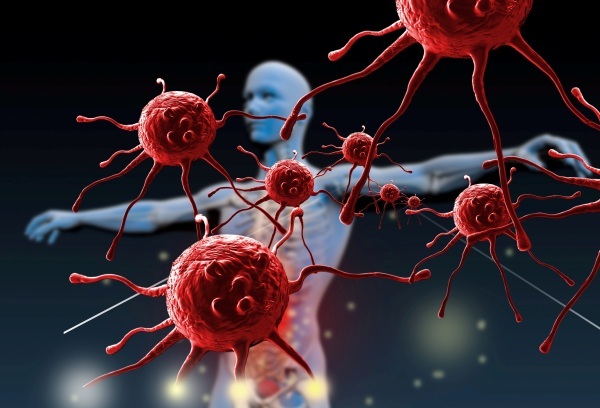
- donating blood for genetic testing for the likelihood of transmitting a defective gene that causes primary immunodeficiency of congenital etiology;
- during pregnancy, a woman should regularly undergo scheduled examinations by a gynecologist, and also take all prescribed tests;
- while carrying a child, do not take medications, the active components of which are able to overcome the placental barrier, penetrating into the tissues of the fetus;
- eliminate foci of chronic infection in the body.
In most cases, children with primary immunodeficiency are born to young men and women who have blood relatives with similar diseases. This is a hereditary factor, which can only be predicted by the results of genetic testing of future parents.
Treatment methods
The main methods of treatment of primary immunodeficiency are in the implementation of the prevention of bacterial, viral and fungal infections, enzyme replacement therapy, taking immunomodulatory drugs and vitamins.
Medications
To maintain the functions of the passive immune system, the following drugs are used: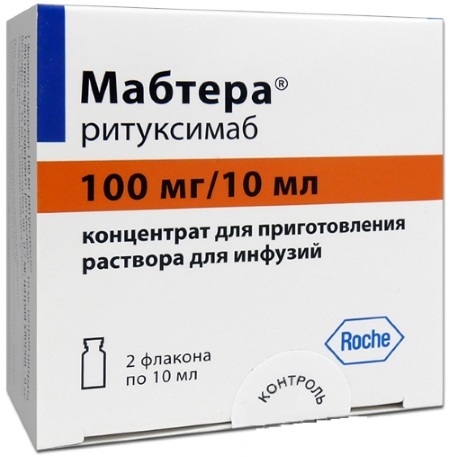
- Mabthera Is an injectable drug based on the active substance rituximab, which is injected into the patient's body in as part of intravenous droppers, is a source of monoclonal antibodies (the average cost of a medication is 76,000 rub. per bottle of 500 ml);
- Prolia Is a therapeutic solution for intravenous injections, which enhances the protective functions of the immune system (the price of the drug in pharmacies is 12,900 rubles. per bottle 60 ml);
- Alfarekin Is an immunomodulator that supports a weakened immune system in the fight against pathogenic microorganisms (the drug is intended for injection, and its average cost is 7,500 rubles);
- Cycloferon - This is an effective immunomodulator, which is injected into the patient's body in the form of intramuscular or intravenous injections (the price of the medication is 1800 rubles. for 5 ampoules of 2 ml).
The duration of therapy and the dosage of the above drugs are determined individually, depending on the type of primary immunodeficiency, the patient's age, and the presence of possible complications.
Traditional methods
Traditional medicines are not used in the treatment of primary immunodeficiency.
Other methods
One of the experimental methods for treating primary immunodeficiency is the correction of a genetic defect using genetic engineering, but this therapeutic technique is not yet perfect.
Depending on the type of pathological state of the immune system, surgical intervention can be used, which consists in bone marrow transplantation from a compatible donor. This method is effective in the treatment of primary immunodeficiency with a violation of the cellular link of the immune system. The operation is performed in a sterile operating room under general anesthesia.
In some cases, the method of neutrophil transfusion is used, as well as the replacement of immunoglobulins. All therapeutic manipulations are carried out in clinics and medical centers specializing in the treatment of hematological and genetic blood diseases.
In 2018, a domestic drug based on class G immunoglobulins successfully passed the stage of clinical trials. The drug is completely safe and can be used for the complex therapy of primary immunodeficiency, but the drug has not yet entered mass production.
Possible complications
Lack of supportive therapy to preserve function the body's immune system, entails the development of the following complications:
- bacterial blood poisoning;

- the formation of chronic foci of infection;
- inflammation of the gastrointestinal mucosa;
- the appearance of ulcerative formations in the oral cavity;
- chronic allergic reactions;
- retardation in physical and mental development;
- damage to internal organs by tumor neoplasms;
- anemia;
- depletion of the body;
- the onset of a lethal outcome.
Immunodeficiency of the primary type is a hereditary or acquired disease, the occurrence of which occurs even during the period of intrauterine development. Pathology is characterized by complete or partial dysfunction of the immune system.
Children and adults with primary immunodeficiency suffer from chronic diarrhea, hepatitis, bacterial infections of the respiratory and digestive organs. Most patients with this diagnosis have malformations of the thymus, parathyroid glands, and cardiovascular system. The disease is characterized by a high mortality rate.
Video about primary immunodeficiencies
About primary immunodeficiencies:



